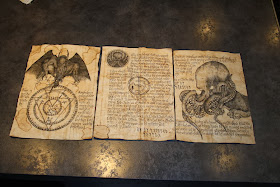I've been doing some more research on classic-era packing options. For years I've been using spanish moss and wood excelsior as a packaging material, since it looked nice, was readily available, and seemed plausibly period. It was only while finishing up the
"Deep One" fetus project that I actually started to wonder just how period it was.
Yes, I'm aware such thoughts are probably a sign of incipient madness. Heh.
I had originally believed there wouldn't be much material on the subject available, but that turned out to totally wrong. There's a huge amount of surviving literature, most of it targeted at commercial shippers. That includes not only manufacturers and producers, naturally interested in getting their products to market without damage, but the entire shipping industry itself, commonly referred to as the express trade.
In general, and this was a real surprise, small packages in the 1920s were done exactly as they are today- a corrugated cardboard box filled with cushioning material. This period ad demonstrates that nearly every type of package available today was around in the classic era.
Notice anything missing from those boxes? Packing tape. Gummed tape was available, but it wasn't regularly used because of issues with moisture and abrasion resistance. Cardboard boxes were held shut with twine or strapping, giving us the familiar image of a package wrapped in kraft paper and twine. It would be years before tape would replace twine as the go-to closure method.
In almost every case the cushioning material filling those cardboard boxes was excelsior or wood wool made from fine wood shavings. It was cheap and readily available, produced in both formed sheets and loose bales at mills across the United States.
Because excelsior can be somewhat abrasive items were frequently wrapped in lightweight paper before being nestled inside the fibers. This was usually tissue paper or newsprint, available in both sheets and rolls to professional shippers. Old newspapers were the wrapping of choice for consumer packages. In most large cities there were multiple papers printing both a morning and evening edition, so there was a huge supply available for recycling.
The wooden shipping crate filled with excelsior we've seen in so many movies was normally limited to extremely delicate items, like glassware, or particularly dense objects along the line of machine parts. Crating only made economic sense when the added protection and weight, and hence cost, was a fractional expense compared to the value of the item.
What's really interesting is just how advanced crate technology was. I know that sounds like an oxymoron. After all, a crate is just a wooden box. But there was a huge variety of crates available, each tailored for a specific purpose using sophisticated construction techniques. The familiar box made of nailed together boards was only the most basic type. By the early 20s manufacturers had perfected the use of lightweight plywood in box construction and were beginning to use ultra-thin wood panels reinforced by internal pressure. In some cases compression was mitigated using tightly packed excelsior, but they were also using "springs" made from bowed wooden struts. Box skins were also being tensioned using strapping and twist-bound wire.

I've probably spent more time looking into this than the subject really deserved, but I started to find it interesting in and of itself. One thing that comes up again and again when researching classic era technology is how often we underestimate it's capabilities. I never would have thought that the myriad of shipping boxes on the shelves today were available back in the 20s, much less in substantially identical form.
















































